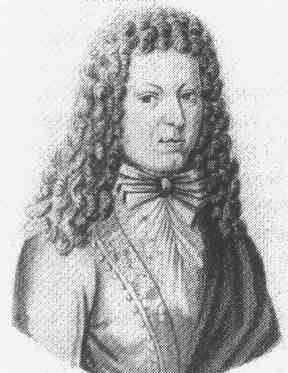


Johann Kuhnau
Anonymous interpretation of 1830+ of unknown original
Source:
Bach Cantatas
Born on 6 April 1660 in Geising, Bohemia, in present-day Saxony, Lutheran composer, Johann Kuhnau, presages high baroque in Germany. Kuhnau is noted for his clavier sonatas, also writing cantatas and such as an author of sacred music. Along the way he also translated texts from Hebrew, Greek, Latin, Italian and French to German and wrote humorous novels. Of the huge corpus of works to which he applied himself numerous are lost including all of nearly fifty secular works. The earliest and principle source of knowledge about Kuhnau is from Johann Mattheson's 1740 'Grundlage einer Ehrenpforte'. [This is available to read at refs below with links for other publications herein mentioned.]
Kuhnau sang at the School of the Cross and the Church of the Holy Cross in Dresden as a child from about age ten, there commencing his study of foreign languages along with music. He fled the plague in Dresden at age twenty (1680), returning to Geising briefly, then leaving to study in Zittau before enrolling at Leipzig University (est. 1499) in 1682 to study law.
In 1684 Kuhnau succeeded August Kühnel as organist at St. Thomas Church in Leipzig leading to a double career as both an advocate and composer. Here is the home of high baroque.

St. Thomas Lutheran Church
Source: Wikimedia
Commons
In 1688 Kuhnau published his dissertation, 'Jura circa musicos ecclesiasticos', addressing ecclesiastical music. Come Book 1 of his clavier exercises, 'Neuir Clavier-Ubing', in 1689 followed by Book 2 in 1692. In between arrived his comical novels of 1691, 'Musicus curiosus, oder Battalus' ('The Inquiring Musician') and 'Musicus magnanimus, oder Pancalus' ('The Magnanimous Musician').
'Frische Clavier Fruchte' ('Fresh Clavier Fruit'), a volume of seven sonatas, arrived in 1696. This was Kuhnau's most popular collection for clavier, reprinted five times to as late as 1724. Per the title at its word, Kuhnau intended this work for a stringed keyboard (clavier) like harpsichord, but to hear it on organ would have been expected.
'Frische Clavier Früchte' 7 sonatas for solo keyboard by Johann Kuhnau 1696
Clavier: Fernando De Luca
'Ciacona in B' No.1 of Sonata 6 of 'Frische Clavier Früchte' 1696
For solo keyboard by Johann Kuhnau
Organ: Gabriel Isenberg
Kuhnau's satirical novel, 'Der Musickalische Quacksalber' ('The Musical Charlatan') saw publishing in 1700. His six Biblical sonatas, 'Musicalische Vorstellung einiger biblischer Historien', appeared in 1700 as well, a fourth collection for solo clavier. Kuhnau had also been appointed musical director at Leipzig University in 1700.
'Musicalische Vorstellung einiger biblischer Historien' Aka 'Biblical sonatas' 1700
For solo keyboard by Johann Kuhnau
Harpsichord: Aniko Horvath
From 1701 to 1722 Kuhnau was Cantor at St. Thomas Church. He was meanwhile musical director at the Paulinerkirche (built 1231) of Leipzig University from 1701 to 1722 as well. Kuhnau's Miserere, 'Gott sei mir gnädig' ('God have mercy on me') arrived in 1705. The Miserere is a setting to Psalm 50 or 51 depending on version of the Bible. Kuhnau's sacred motet, 'Tristis est anima mea' ('Sad is my soul') appeared about 1705 as well.
'Gott sei mir gnädig' Miserere in C minor by Johann Kuhnau 1705
'God have mercy on me' ('Miserere mei, Deus')
For 9 voices w orchestra of 2 violins / 2 violas / violoncello / basso continuo
Text: Psalm 50/51: 3-10
Bach Collegium San Diego / Ruben Valenzuela 27 Sep 2014
'Tristis est anima mea' Sacred motet in F minor by Johann Kuhnau c 1705
'Sad is my soul' for 5 voices
Text from Chapter 26 of 'Matthew' (Gospel)
Dresden Kreuzchor / Rudolf Mauersberger
His 'Uns ist ein Kind geboren' containing eight movements including a sinfonia and three arias may have been finished in 1720, not published until 1884. This is often identified as Bach BWV 142, though Bach's authorship has long been doubted in favor of Kuhnau. Another of his later works was 'Lobe den Herrn, Meine Seele' published about 1722, a cantata for Psalm 103 for alto, bass, oboe d'amore, violin & continuo. It isn't known when he completed his 'Magnificat' in C major for Maundy Thursday with text from Matthew 26:38. This is his largest existing work for voice written for solo SATB and chorus SSATB with orchestra including carols by Johann Schelle who had preceded Kuhnau as Cantor at St. Thomas.
'Uns ist ein Kind geboren' Christmas cantata by Johann Kuhnau 1720
'A child is born to us' Libretto: Erdmann Neumeister
For 4 voices w orchestra of 2 recorders / 2 oboes / 2 violins / viola / continuo
Indianola Presbyterian Church Festival Choir & Chamber Orchestra
Conducting: Christopher Dent Organ: Orlay Alonso 6 Dec 2015
'Magnificat' in C major by Johann Kuhnau Date unknown
For 4 voices w chorus of SSATB w orchestra Text: Matthew 26:38
Amsterdam Baroque Choir & Orchestra
Conducting / organ: Ton Koopmann Soprano: Deborah York Leipzig Bachfest 2003
It was upon Kuhnau's death on 5 June 1722 that Johann Sebastian Bach, namely high baroque, succeeded him at St. Thomas. Among other accomplishments including those lost were 'Disputatio de Triade', 'Introductio ad Compositionem', 'Tractatus de Tetrachordo' and an opera titled 'Orpheus'.
Sources & References for Johann Kuhnau:
David Mason Greene (Greene's biographical encyclopedia of composers / Piano Roll Foundation 1985)
Rita Laurance (All Music)
Aryeh Oron (Bach Cantatas)
Georg Predota (Interlude)
Joseph P. Swain (Historical Dictionary of Baroque Music / Scarecrow Press 2013)
VF History (notes)
Audio of Kuhnau: Classical Archives
Compositions: Corpus:
Compositions: Individual:
Magnificat / C major / date unknown: Ficks Music
Tristis est anima mea / sacred motet / c 1705:
Uns ist ein Kind geboren / Christmas cantata / 1720:
Glossary / Terminology:
Cantata Magnificat Miserere Motet Sonata
Publications: Kuhnau: Music: Clavier: Chronological:
Neue Clavier-Übung / Book 1 / 1689: IMSLP
Neue Clavier-Übung / Book 2 / 1692: IMSLP
Frische Clavier Fruchte / completed 4 May 1696:
Musicalische Vorstellung einiger biblischer Historien / Biblical sonatas / 1700:
Internet Archive (digital copy)
Works for Clavier (all 1689-1700 / Dr. Norbert Müllemann)
Publications: Kuhnau: Novels: Alphabetical:
Der Musickalische Quacksalber / The Musical Charlatan / 1700:
Internet Archive (digital copy)
Musicus curiosus, oder Battalus / The Inquiring Musician / 1691:
Internet Archive (digital copy)
Library of Congress (digital copy)
Musicus magnanimus, oder Pancalus / The Magnanimous Musician / 1691:
Internet Archive (digital copy)
Publications: Kuhnau: Theory:
Jura circa musicos ecclesiasticos / 1688:
Bodleian Libraries (digital copy)
Google Books (digital copy)
Publications: Johann Mattheson / Grundlage einer Ehrenpforte / 1740:
GDZ (digital copy)
Google Books (digital copy)
IMSLP (digital copy)
Internet Archive (digital copy)
Recordings of Kuhnau: Catalogs:
Discogs Music Brainz Presto RYM
Recordings of Kuhnau: Select:
Musicalische Vorstellung einiger biblischer Historien (organ by Richard Apperley / Bandcamp)
Musicalische Vorstellung einiger biblischer Historien (organ by Stefano Molardi / Brilliant Classics)
Sacred Music by Johann Kuhnau (The King's Consort / Robert King / Helios 1998)
Scores / Sheet Music: Corpus:
CPDL (choral works)
TheOneAndOnlyZeno (with audio at YouTube)
Urtext Edition (works for keyboard 1689-1700 / Müllemann / 2014)
Scores / Sheet Music: Individual:
Gott sei mir gnädig (God have mercy on me / Miserere / 1705)
Tristis est anima mea (Sad is my soul / sacred motet / c 1705)
Further Reading:
Wikiwand (Paulinerkirche at Leipzig University)
Bibliography:
Susan Jones Bruno (The Published Works of Johann Kuhnau / University of Connecticut 1986)
Erik Kjellberg (The Dissemination of Music in Seventeenth-century Europe / Peter Lang 2010)
Richard Münnich (Johann Kuhnau: Sein Leben und Seine Werke / Breitkopf & Härtel 1902)
Evangeline Rimbach (The "Magnificat" of Johann Kuhnau / Bach Vol 11 No.4 / Oct 1980)
J.S. Shedlock (The Pianoforte Sonata: Its Origin and Development / Good Press 2019)
Authority Search: BnF Data VIAF World Cat
Other Profiles:
Janelle Davis (The Kuhnau Project / audio 2015)
George Grove (A Dictionary of Music and Musicians /1900)
George Grove (A Dictionary of Music and Musicians ... by Eminent Writers, English and Foreign / MacMillan & Co 1880)
Dr. Norbert Müllemann (G. Henle Verlag 2022)
Richard Münnich (Sammelbande / Vol 3 / Breitkopf & Härtel 1902)
J.S. Shedlock (The Pianoforte Sonata: Its Origin and Development / Methuan & Co / London 1895)
Wikipedia Deutsch Wikipedia Français
Classical Main Menu Modern Recording
hmrproject (at) aol (dot) com